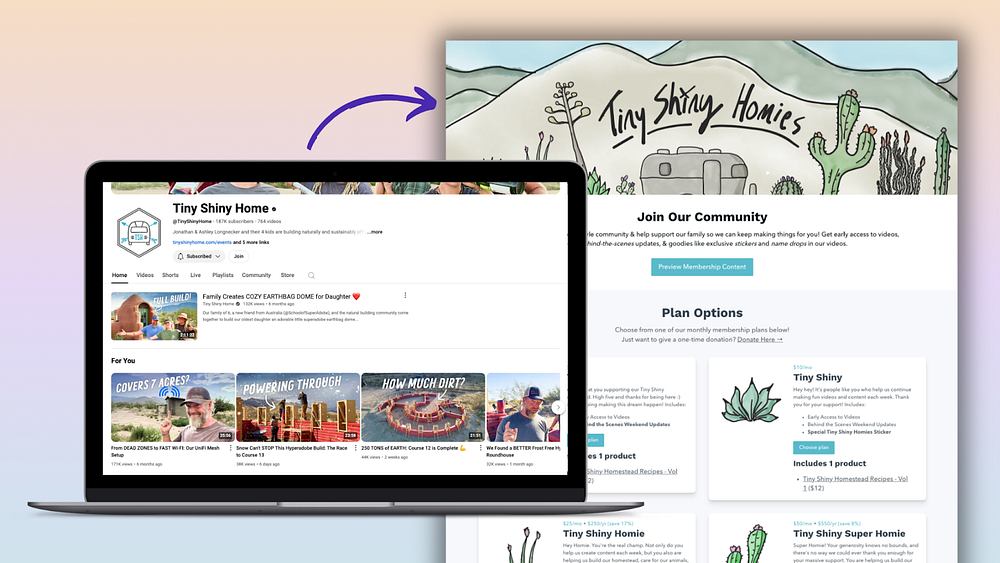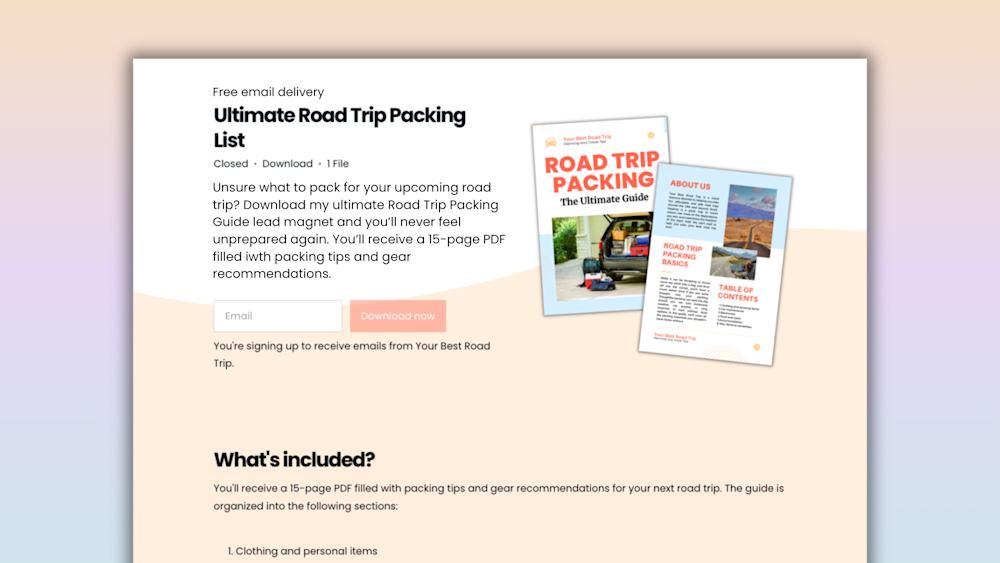Your favorite electric kettle breaks: no matter how many times you flip the switch, it won’t boil.
Rather than brave the weekend traffic, you turn to Amazon. And bingo! Amazon has hundreds of kettles for you to choose from.
How do you sort through them?
If you’re like most people, you turn to the reviews.
Whether you're selling in a competitive subject area, or you're the only game in town -- customer reviews are critical for selling digital products and online courses.
And the more reviews you have, the better.
But if you’re just starting out, scoring reviews can feel downright daunting. How do you find customers willing to advocate for your courses? How do you ask for reviews without seeming pushy?
In this article, we’ll answer all of those questions and more, getting down to the brass tacks you need to land testimonials for your sales pages.
But before we dive into how to get reviews, let’s dig deeper into just how powerful they can be for your online course sales.
Why reviews are your hidden ace
Ammi Borenstein, CEO of Transitions2earth, highlights the value of reviews for businesses with homepages:
“We truly regard product reviews almost as good as a form of currency. The more we have on any given products, the more we see sales continue to grow.”
But do the numbers back that claim up?
As it turns out, they do.
User-generated content, such as reviews, can increase conversion rates by 133%.
And if that’s not enough, reviews can help your sales climb by 18%, too.
But even better than that: asking for and responding to feedback can prevent 11% of your customers from taking their business elsewhere (also known as “churning”).
Plus, if that feedback lets you respond and correct customer issues at the first engagement, you can stop 67% of your current churn in its tracks.
Reuven Lerner, online course creator and professional trainer, used feedback from his audience to shape the journey of his homepage, and he says it was the pivotal moment for changing his business.
So, needless to say, online reviews are a must-have tool in your sales arsenal.
But don’t limit them to just driving current sales: they can be just as powerful for shaping future sales, too.
That’s what The Container Store discovered when they used customer feedback and reviews to launch one of their biggest hits.
Patrick Burk, the Customer Content Manager for the brand, explains:
“As a direct result of customer-review feedback, we started offering a tall shoe box, and it’s been a major hit from the get-go by every metric imaginable.”
Just imagine what it can do for your metrics if you can leverage the customer voice for your future courses.
Let’s check out how some online tribe leaders are using reviews and testimonials to their advantage on their websites.
Compass of Design uses customer testimonials to highlight the value of the learning community and overcome potential roadblocks by having customers outside of design weigh in on their experiences.
Collin Belt takes a different approach, leveraging customer testimonials to establish himself as an authority in his field and position his services for both potential clients and students.
Finally, Adam Clark intersperses previews of his learning modules with customer reviews, elaborating on the value of his course and learning objectives as users scroll through his page.
Ultimately, how you use your customer reviews will depend on your audience and specific objectives – whether you want to grow your outreach or expand your sales – but the one thing that is clear is this:
Customer reviews are the ace up your sleeve to overcome customer hesitation and objections. You need them for better sales.
So with that out of the way, let’s talk about where to find your reviews.
Where to source reviews
OK, you’re on board: flaunting customer reviews and testimonials are a must-have.
Now all you have to do is hit up your email list, right?
It’s a little more complicated than that.
Email shouldn’t be your only channel for getting customer feedback. Neglecting social media can mean missed opportunities and leads.
Here’s the good news:
Social platforms have features that make it easy for you to source reviews. LinkedIn, for instance, has recommendations that display directly on your profile.
Becky Mollenkamp has over twenty of these recommendations singing her LinkedIn course’s praises and adding major credibility to her name.
Requesting recommendations on LinkedIn is easy. Let’s take a quick run through it now.
After adding your students on LinkedIn, pop over to your main feed. Click on the drop-down menu under “me” in the top navigation bar.
From there, click “view profile.”
Scroll down until you come to the module titled “recommendations.”
Then, click on “ask for a recommendation.”
Now, type in the name of someone you want to request a recommendation from. As you begin typing, you’ll see results from your connections populate beneath the search box.
Once you’ve located the person you want, click on their profile and go to the next screen.
From here, use the drop-down menus to describe your relationship with the person. If they’re a student, select “was a client of yours.”
Once you’re done, proceed to the next screen.
From here, you can send your request with the default message, but if you’re trying to land recommendations for your course, it’s worth mentioning that in your request.
Once you’re ready, hit the “send” button. And that’s all there is to it!
You can also use the polling feature on Twitter and Instagram to get more customer feedback. Try to ask specific questions that new customers might want to know, such as:
-
How long did my course take you to finish?
-
Did my course help your confidence?
-
Would you take another course from me?
Note that it may be worth direct messaging or pinging your students to your polls, as well as reposting it a few times throughout the week in case people missed it – just make sure you’ve built a good rapport with your followers to avoid coming off as spammy.
OK, now that you know where to find reviews and how to ask for them over social networks, let’s talk specifically about email.
How to ask over email
Here’s a surprising twist.
Reviews help your higher-priced items more than your lower-priced products. So it’s more impactful to focus your effort on your higher-priced items than lower-priced when you’re starting to build your reviews.
And email is definitely the front-line for getting reviews, especially if you’re using an automated form.
74% of your customers are more likely to respond to an online survey or feedback form over more invasive requests, such as online chats and phone calls.
Do you notice how “quick” is the qualifying word in that data?
It’s an important one to remember when you’re asking for reviews.
People are busier than ever, and it shows in online reviews.
Compared to 2010 when customers would leave reviews upwards of 600 characters, the average review in 2017 was roughly 200 characters.
Beyond making it convenient and short for your customers, what are the other critical ingredients for getting reviews?
A combination of the right subject line and asking
Specifically:
Don’t rely on emotional triggers in your subject line and do include your site's name, says data from three and a half million reviews.
And, before we go any further, a quick word of caution about offering incentives:
While you may be able to garner more reviews with this practice, it’s frowned on – both professionally and legally – and many of the larger review organizations will penalize businesses caught incentivizing their customers.
Consider, for instance, this law firm that lost almost 100 reviews once Google discovered they were offering family zoo passes in exchange for reviews.
Even offering discount coupons can land you in hot water.
So, as a best practice, don't incentivize reviews through email or social media, but if you do, absolutely ensure the reviewer discloses the incentive in the review.
With that out of the way, let’s look at some examples of businesses asking for reviews through email and get down to the nitty-gritty of the “ask.”
GreenWorlds is an online furniture retailer, and in their message we see the same emphasis on brevity.
So, make your request quick, and if you can, use the opportunity to address any customer concern issues.
If you don’t have your website set up to accept reviews, you can use Google Forms to quickly set up a survey. Alternatively, Typeform is another excellent free platform you can use.
Here’s a template you can use to start asking for reviews for your course with your new form.
Testimonial request template
Let’s plug this into our email campaign on Podia real fast and take it for a spin.
By the way, feeling nervous about sending out your email? Turn it over to Podia’s drip campaign system.
This not only takes the anxiety off your shoulders, but it can also increase your click rate by 5%.
This brings us to our final stage for reviews and feedback: how to bring it all together on your Podia homepage.
Adding reviews to your sales page
The faster your customers can source your product reviews, the less friction and effort they have to expend before they can reach a decision.
So if they can see proof positive of your online course awesomeness without leaving the page? That’s the best of all worlds.
Reducing the number of steps between your customer and your product is customer experience at its finest, whether the journey is between product and purchase or purchase and satisfaction.
Just make sure any reviews you’re adding to your course page are enriching the page and not filling up space.
Adding relevant customer testimonials helps build more than conversions, too. It's also critical for trust.
Let’s look at how different creators combine their customer reviews on their Podia site pages.
Robert Joyner knows the power of simplicity. He adds thoughtful quotes to the bottom of his product pages and keeps it authentic.
But if you’re looking for a little more thrills, consider Justin Jackson’s approach. He adds quotes and provides links to the original source, giving him a major boost to credibility and social proof.
Finally, there’s the case of David Delahunty, whose visuals create a stunning and persuasive picture.
You can easily add your reviews to your Podia website and sales pages with Podia's testimonial section. It comes with pre-designed layouts so all you need to do is type in your reviews and go.
The hard part is getting the reviews. Once you have those, you can easily tie them directly into your sales pages to increase conversions, build trust, and add some pizzazz to your course.
Leverage the power of reviews and testimonials
Think reviews are just for the big dogs? Think again. The majority of shoppers trust an online review as much as their BFF. To get reviews, do this:
-
Don’t limit your collection to your website or email. Social media is ripe with opportunities to find and showcase your happiest customers.
-
Use LinkedIn’s recommendation request feature to ask for some professional accolades directly from your favorite students.
-
You might be tempted to offer an incentive to get reviews, but be careful. If you do provide an incentive, make sure the reviewer discloses their relationship with you from the get-go.
-
When you do ask over email, keep it short and sweet. If you don’t have anywhere to capture reviews on your website, use Typeform to create a quick form.
-
After you’ve landed your reviews, take a breath of relief – the hard part is over. From here, it’s just bringing them all together on your sales page, and Podia makes it easy.
It can be a little intimidating to ask for reviews on our work, but the more reviews you can get, the stronger your courses – and conversions – will become. Try your free trial of Podia today and you'll have everything you need to watch the sales role in!



